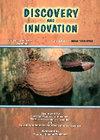Characterisation of chitosan from blowfly larvae and some crustacean species from Kenyan marine waters prepared under different conditions
引用次数: 38
Abstract
Isolation of chitosan from cuticles of blue bottlefly larvae Calliphora erythrocephala, and shells of crab Sylla cerrata, lobster Panulirus ornatus, prawn Paeneaus indicus was carried out. The yield of chitin was 12.0%, 23.0%, 15.7% and 28.0% respectively. In the same order the yield of chitosan was 66.0%, 74.6% 74.3% and 75.0% from chitin. Ash in the crab and lobster chitosan demineralised with 0.5M HCl was 30.2 and 22.4% respectively. This was reduced to 0.2 % for lobster and 0.4% for crab using 2M HCl for demineralisation and 0.5M HCL was adequate for demineralisation of prawns to bring the ash content to < 1%. The ash content in the blowfly larvae was negligible. The conditions used for chitosan isolation in blowfly larvae were milder requiring no demineralisation step. The time to obtain soluble chitosan in 1% v/v acetic acid was 8 hr for crab and lobster at 100°C deacetylation and 4 hr at 120°C while for prawns it was 6 hr at 100°C and 3 hr at 120°C deacetylation temperature. The average molecular weight ( ̄M V ) for crabs was 556,000 after 8 hr deacetylation and 148,000 at 140°C deacetylation temperature. With 2M HCl used for demineralisation first, it was 439,000 for a 4 hr period. Crabs, first demineralised then deprotenised the ̄M V was 155,000 for a 3 hr deacetylation at 120°C and 417,000 for 1 hr deacetylation. An 8 hr deacetylation at 100°C for lobsters gave ̄M V of 791,000. It was reduced to 560,000 after 4 hr of deacetylation at 120°C and to 236,000 at 140°C for 3 hr. Prawns had a ̄M V of 507,000 after 6 hr deacetylation at 100°C and reduced to 455,000 after a 3 hr deacetylation. For insect larvae, at 100°C deacetylation for 4 hr the ̄ M V was 413,500 while for 1 hr, 2 hr and 2.5 hr deacetylation time at 120°C it was 369,000, 308,500 and 263,000 respectively. The degree of deacetylation (DD) increased with temperature and time of deacetylation. For crab, demineralised then deproteinised, it increased from 72.9% in 1 hr then 81.5% in 3 hr. In prawn chitosan it was 60.0% for the 6 hr deacetylation at 100°C and 69.2% for 3 hr deacetylation at 120°C. The DD of insect larvae was 62.56% after 4 hr of deacetylation at 100°C. When deacetylated at 120°C it was 64.0% after 1 hr, 79.9% after 2 hr and 80.7% after 2.5 hr. The moisture content showed a slight increase with DD. Temperature increase and time of deacetylation caused a decrease in ̄M V and a more conservative increase in DD.在不同条件下制备肯尼亚海水中苍蝇幼虫和一些甲壳类动物壳聚糖的特性
研究了从蓝瓶蝇幼虫表皮、蟹壳、龙虾壳和印度对虾壳中分离壳聚糖的方法。甲壳素得率分别为12.0%、23.0%、15.7%和28.0%。壳聚糖的收率依次为66.0%、74.6%、74.3%和75.0%。0.5M盐酸脱盐后,蟹壳和龙虾壳聚糖灰分分别为30.2%和22.4%。使用2M HCl进行脱矿,龙虾和螃蟹的灰分分别降至0.2%和0.4%,对虾用0.5M HCl进行脱矿就足以使灰分含量低于1%。苍蝇幼虫的灰分含量可以忽略不计。在苍蝇幼虫中分离壳聚糖的条件较温和,无需脱矿步骤。在1% v/v的乙酸中,螃蟹和龙虾在100℃脱乙酰化条件下得到可溶性壳聚糖的时间为8小时,在120℃脱乙酰化条件下得到4小时,对虾在100℃脱乙酰化条件下得到6小时,在120℃脱乙酰化条件下得到3小时。脱乙酰8小时后螃蟹的平均分子量为556,000,脱乙酰温度为140℃时为148,000。首先用2M HCl进行脱矿,在4小时内为43.9万。螃蟹,首先去矿化,然后去蛋白化,在120°C下,3小时去乙酰化的V值为155,000,1小时去乙酰化的V值为417,000。龙虾在100°C下进行8小时的去乙酰化,得到的mv为791,000。在120℃下脱乙酰4小时后还原为560,000,在140℃下还原3小时后还原为236,000。在100°C条件下,脱乙酰6小时后,对虾的mhv为507,000,脱乙酰3小时后降至455,000。昆虫幼虫在100℃脱乙酰4 h时的mv值为413500,而在120℃脱乙酰1、2、2.5 h时的mv值分别为369000、308500、263000。脱乙酰化程度随脱乙酰化温度和时间的增加而增加。螃蟹先去矿后去蛋白,从1小时的72.9%增加到3小时的81.5%。对虾壳聚糖在100℃下6小时的脱乙酰率为60.0%,在120℃下3小时的脱乙酰率为69.2%。100℃脱乙酰处理4 h后,幼虫的DD为62.56%。在120℃下脱乙酰,1小时后为64.0%,2小时后为79.9%,2.5小时后为80.7%。随着脱乙酰温度的升高和脱乙酰时间的延长,水分含量略有增加。
本文章由计算机程序翻译,如有差异,请以英文原文为准。
求助全文
约1分钟内获得全文
求助全文

 求助内容:
求助内容: 应助结果提醒方式:
应助结果提醒方式:


